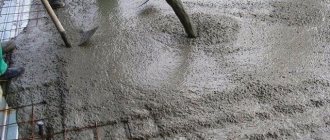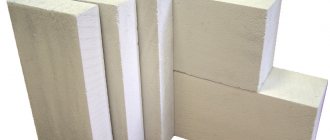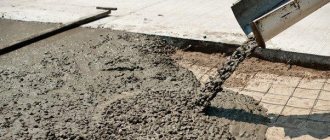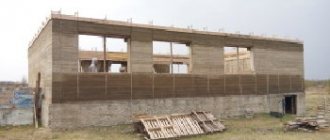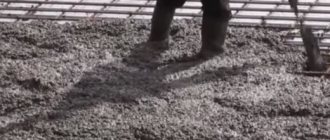The mobility of the concrete mixture is necessary to carry out work and ensure high quality concrete in the structure. Depending on the composition, the concrete mixture can have a different consistency - from liquid to thick (doughy) and hard, barely wet
To fully evaluate a concrete mixture you need to know:
- Is it convenient to mix it in stirrers?
- is its mobility sufficient, i.e. the ability of the mixture under the influence of its own weight to move along inclined gutters and pipes or to spread out when unloading from them;
- Is it easy to immerse shovels, rods, rammers, vibrators and other tools intended for mechanical processing of concrete mixture into the concrete mixture;
- Is it easy to fill forms with concrete mixture under the influence of its own weight, bayonet or under the influence of high-frequency oscillations - vibration;
- what is the cohesiveness of the concrete mixture, will it delaminate during transportation, unloading and laying.
Where is roller concrete used?
It is very easy to identify concrete of this type - when it is vibrated and tamped, only traces of water appear on the work table, while water flows out in significant quantities from ordinary concrete.
In addition, rigid concrete is characterized by a low cement content, the possibility of using construction waste as a filler and the use of crushed stone as the main filler. In this case, a distinction is made between coarse-grained rigid concrete and fine-grained rigid concrete - crushed stone fraction up to 40 mm and up to 5 mm, respectively. These factors are both the main advantages and the main disadvantages of this material.
Along with reducing the cost of concrete (due to less cement and water), rigid concrete requires greater energy costs for mixing, compaction and quality control.
Rigid roller concrete is used in the following areas of construction:
- Construction of cushions on monolithic and prefabricated foundations;
- Sealing holes in foundation blocks;
- As a base for road surfaces and screeds;
- Rigid concrete is used as a base for pouring concrete floors directly onto the soil. In this case, it effectively stabilizes the soil base;
- For the manufacture of interfloor ceilings, lintels, strips, etc.;
- During the construction of bases and coverings using single-stage technology (at the 1st stage) and two-stage construction of roadways, pedestrian sidewalks and concrete platforms for various purposes.
The use of rigid concrete is justified in cases where the building or structure, due to the construction conditions, is subject to significant load immediately after its construction. In cases where a long period of strength gain is acceptable, it is economically and technologically more expedient to use traditional “plastic” types of concrete mixtures.
If, for one reason or another, there is a significant time gap between the rolling of rigid concrete and the installation of the “finishing” coating, the concrete must be protected from evaporation of the compound with plastic film or other traditional methods.
What is the hardness of a concrete mixture?
The concept of concrete mixture rigidity is a technological characteristic of the workability of the material. The method for determining this indicator is based on measuring the time during which the cement mixture completely settles, compacts and levels out.
This indicator must be measured in a specially molded cone and on a specially prepared vibrating platform. In this case, the maximum grain size of the concrete mixture filler can be 4 cm. The test time period is from the moment the laboratory equipment is turned on until the concrete block begins to appear in the holes of the installation disk (at least 2). Measurements are recorded in seconds.
Advantages of Rigid Rolled Concrete
- Significant cost reduction due to lower binder content. Accordingly, a significant reduction in retail and wholesale prices. For example, the price of rigid concrete grade M200 with gravel filler ranges from 3,090 to 3,160 rubles per 1 m3. At the same time, “traditional” concrete M200 on gravel costs on average from 3,500 to 4,200 rubles per 1 m3, depending on the manufacturer.
- Significant reduction in production time for concrete work due to the elimination of a long period of time for gaining grade strength.
- Possibility of use as a filler: old asphalt concrete, local limestone, waste from the production of reinforced concrete products and other “stone” waste from one or another production.
- Excellent performance.
- Laying coatings on a base made of hard concrete is permitted immediately after compacting it. This allows you to “omit” (not apply) measures for the care of concrete structures and products.
- The use of mineral additives is allowed - additional savings on cement.
Hardness grades according to GOST 7473 2010
According to GOST 7473-2010, the following grades of concrete mix hardness are established:
| Brand | Hardness, seconds |
| Zh1 | from 5 to 10 |
| Zh2 | from 11 to 20 |
| Zh3 | from 21 to 30 |
| Zh4 | from 31 to 50 |
| Zh5 | from 50 |
Concrete mixture Zh1 is considered the least rigid, Zh5 - the most rigid. The longer it takes for shrinkage and compaction to occur, the stiffer the concrete is.
Disadvantages of Rigid Rolled Concrete
The conspicuous simplicity of the technology of compacted concrete, however, has a number of assumptions and difficulties when arranging certain structures:
- Due to the individual characteristics of the technology for laying long pavements (highways, highways, intracity roads), it is significantly difficult to ensure uniform rigidity along the entire length of the laying. This means the need to provide at least 30 meters of coverage in front of the working part of the roller;
- This material is very capricious in terms of adherence to technology, in particular to strict adherence to laying times and rolling;
- During the construction of foundations, it is possible to form zones of heterogeneous strength and density;
- Significant increase in energy costs for compaction.
To summarize, it makes sense to focus on the experience of using rigid concrete during the reconstruction of the ring road in the capital of the Russian Federation and the nuances that emerged.
The experience of large-scale construction of a concrete foundation to cover the Moscow Ring Road revealed the need to improve the existing technology. In particular, it is necessary to increase the homogeneity of concrete and improve its quality.
Cone for determining the mobility of a concrete mixture
Many instruments and methods have been proposed to evaluate the properties of a concrete mixture. Below are two of them that are most widely used on construction sites and in laboratories. Both of these methods should be used simultaneously, as they complement each other. A standard cone is used to determine spreadability (under the influence of its own weight and cohesion of the concrete mixture. This is a truncated cone, open on both sides, made of sheet steel 1 mm thick. The cone is placed on a wooden square stand 70x70 cm upholstered with roofing steel.
Test method
The test method is as follows: the form is moistened with water and placed on a stand, after which it is filled in three layers (10 cm each) with a concrete mixture taken directly from a concrete mixer, or a mixture brought to the installation site. Each layer is pierced (without impact) with a steel rod (75 cm long, 15 mm in diameter) 25 times. During filling and bayoneting, the cone is pressed tightly against the stand with your feet. Immediately after filling the cone and removing the excess concrete mixture, the mold is removed by lifting it slowly and strictly vertically by the handles. The moving concrete mixture, released from the mold, settles or even spreads. Immediately after removing the mold, the settlement is measured (in millimeters) by applying a ruler and meter to the cone. A sample is taken from each batch twice, the cone slump is measured and the average result is taken.
Rice. Standard cone for determining the mobility of a concrete mixture: 1 - steel form, 2 - handles, 3 - rivets, 4 - stop.
The amount of cone slump is a measure of the mobility of the concrete mixture. The cone settlement (its abbreviated designation is OK) is also called float.
There are concrete mixtures: rigid, mobile and cast.
Rigid concrete mix
but the humidity level is reminiscent of damp earth, requires compaction, pressing or prolonged vibration during installation, gives a cone settlement close to zero, and is used only for unreinforced or weakly reinforced concrete structures, as well as in the manufacture of concrete parts.
Movable concrete mix
compacted during laying by bayoneting (with a cone draft of 80-150 mm) or short-term vibration (with a cone draft of 10-100 mm); It is most often used for concreting reinforced concrete and concrete structures.
Cast concrete mixture
liquid, when laying it only needs to be distributed in the formwork, it gives a cone settlement of more than 180 mm. Currently, cast concrete mixture is not used, since in this case too much cement consumption is required, otherwise the result will be concrete of reduced strength.
In addition to determining the settlement of the cone, it is necessary to know the workability of the concrete mixture when vibrating, which can be determined in the following way. A standard cone is inserted into a regular metal mold for preparing cubes. The stops are removed from the cone and the lower diameter is slightly reduced so that the cone fits into a cube measuring 20X20X20 cm. Fill the cone as indicated above. After removing the metal cone, the concrete mixture is subjected to vibration in the laboratory area. The vibration lasts until the concrete mixture fills all the corners of the form and its surface becomes horizontal.
The duration of vibration in seconds is taken as a measure of the workability of the concrete mixture. The characteristics of a standard vibrating platform are as follows: - kinetic moment - 1 kg cm, amplitude - 0.35 mm, frequency - 2500-3000 vibrations per minute.
EFFECTIVENESS AND APPLICATION AREA OF RIGID CONCRETE MIXTURES
| The effectiveness of using rigid mixtures can be determined by comparing the cement consumption required to obtain a given strength of concrete prepared using mixtures of different hardness. For comparison, graphs should be constructed expressing the quantitative relationship between the strength of concrete and the distribution Rice. 1 — hardness 20 sec.; 2 — 120 sec.; |
In Fig. Figures 77 and 78 show examples of such dependencies under accelerated and normal hardening modes. The curves in the graphs refer to concrete mixtures prepared with gravel with a maximum particle size of 20 mm
and cement from the Belgorod plant, grade 500.
As can be seen from the graphs, concrete of a given strength can be obtained with lower cement consumption, the greater the rigidity of the mixture. For accelerated hardening modes, use mixtures with a hardness of 100-120 seconds. (normally hard mixtures) allows you to reduce cement consumption by 25-30% compared to low
Mobile mixtures with a hardness of 20-25 sec. For mixtures with hardness of 250-300 and 600 sec. (especially hard mixtures) cement savings can be 40-60%.
With prolonged curing periods, the effectiveness of rigid mixtures decreases somewhat. However, in this case, the saving of cement compared to low-flow mixtures (20-25 seconds) is 15-20% for normally hard mixtures (100-120 seconds) and 30-40% for especially hard ones (400-600 seconds).
The given graphs show that rigid concrete mixtures are especially effective when used to produce high-strength concrete. In this case, cement costs are reduced especially significantly.
In table Figure 37 shows a possible increase in the strength of concrete with constant cement consumption, which is achieved by using rigid concrete mixtures.
As can be seen from the table, the strength of concrete made from rigid concrete mixtures under normal hardening modes, compared to slow-moving mixtures, is 120-150% for normally hard mixtures and 130-180% for especially hard ones, and reaches 200-300% under accelerated modes. '
T? Rice. 78. Dependence of concrete strength on cement consumption for mixtures of different hardness (long hardening periods) A - cement N 3, 7 days; b - cement No. 2.28 days; - 1 - rigidity ZOSek; 2— 250 sec; 3 - 25-30 seconds; 4 — 90-100 sec.; 5 - 400-600 sec. |
Data have already been presented above showing that the use of rigid concrete mixtures makes it possible to reduce the hardening time of products. With constant cement consumption, normally hard mixtures (100-200 sec.) require approximately 1.6 times less steaming time to obtain the same strength and
3 times less holding time in natural conditions than when using low-moving mixtures {25—ZOSek;). For particularly hard mixtures -(300—bOOsec.) long-
| Table 41 Increasing the strength of concrete from rigid concrete mixtures compared to low-slump mixtures (20-25 sec.) Hardness in sec. | Cement consumption in kg/m3 | Relative strength in % in relation to the strength of veton from sedentary mixtures aged | |||||
| 1 day | 3 days | 7 days | 28 days | When steaming according to the mode | |||
| 2-2-0 | .3-8-3 | ||||||
| 300 | 225 | 160 | 150 | 135 | 175 | ||
| 1 L) | 400 | 180 | 135 | 120 | 120 | 140 | _ |
| 300 | — | • — | 160 | — | — | 180 | |
| 400 | — | _ | 130 | — | — | 150 | |
| 300 | 325 | _ | — | 145 | 220 | — | |
| 400 | 220 | —■ | — | 130 | 165 | — |
Hardening life can be reduced by 2 times during heat treatment and 4 times during natural hardening.
Products made from rigid concrete mixtures can be stripped immediately after compaction. This significantly simplifies the technological process of producing hollow and ribbed products, reduces labor costs for stripping, assembling and lubrication of forms, and reduces metal consumption for the mold, turning it into part of the forming unit.
In addition to the listed advantages, increasing the rigidity of the mixture improves the physical and mechanical properties of concrete due to the lower content of water and cement paste, as well as lower porosity and higher density of concrete.
Concrete made from rigid concrete mixtures has less shrinkage than concrete made from low-slurry mixtures, due to the reduced amount of cement stone in the concrete composition. According to A.E. Desov [31], a decrease in water content from 160 to І120 lm3,
That is, by 25% with a constant
VShch,
it reduces the shrinkage of concrete stored for 7 days in conditions of atmospheric humidity, and then at a temperature of 21.5°C and 50% relative air humidity, from 500 to 300°C. that is, almost 2 times. !
Increasing the rigidity of the concrete mixture and the associated decrease in the content of. concrete, cement stone and water reduce the creep of concrete, which is especially important for prestressed structures [97].
Concrete made from rigid mixtures, characterized by a large amount of coarse aggregate or a lower water-cement ratio compared to low-slump mixtures, has an increased elastic modulus, tensile, bending and impact strength [29]. A particularly large difference is observed; as well as when comparing strength indicators* under short hardening modes and high VSC
-(“^current compositions). ■ — -“. —
Concrete made from rigid mixtures, characterized by a reduced content of cement-sand mortar, shows higher resistance to abrasion. Concrete made from rigid mixtures, having an increased density, is characterized by high frost resistance, water resistance and, therefore, durability. This advantage of rigid concrete was clearly proven by the research of G.I. Gorchakov [18]. The experience of manufacturing waterproof reinforced concrete tubes from rigid concrete mixtures [12] also confirms their high efficiency.
The guidelines for the use of rigid concrete mixtures approved by the State Construction Committee (U 110-56) determine that the main purpose of using such mixtures is to save cement compared to low-flow mixtures.
High-strength concrete of grade 500 and above from a low-flow concrete mixture can be obtained with a cement consumption of 500 kg/cm2
more than 500-600
kg/m3,
i.e. such a consumption at which cement is already used with reduced efficiency.
Only the use of rigid concrete mixtures for the production of high-strength concrete can save cement and effectively use its strength properties.
Cement savings can also be achieved with conventional grade 200 concrete, which hardens with an average steaming time. In this case, cement consumption can be reduced from 300-350 kg/m
3 to 200-220
kg/m3,
i.e. by 30-35%.
Let us conduct a technical and economic comparison of the production of reinforced concrete products from rigid and low-flow concrete mixtures.
In table Figure 38 shows the effectiveness of using rigid concrete mixtures on average compared to low-flow mixtures (hardness 20-25 sec.).
Table 42
| Performance indicators of rigid concrete mixtures for equal-strength concrete Rigidity | Cement savings with constant steaming duration | Reducing the duration of steaming while maintaining constant cement consumption | ||
| Concrete. .mixtures 6 sec. | Reduction in cement consumption in % | Increase in coarse aggregate consumption in °/o | Reduction in steaming time in % | Increasing the consumption of coarse aggregate due to a corresponding reduction in consumption - • sand in % |
| 50-60 100 400 | 10 20—25 30—40 | 10 ‘ 15—20 20-25- | 20 33 50 | 3—5 7: — — 12 |
The economic efficiency of the above indicators is calculated by Ph.D. tech. Sciences E. ~ I. Dunaevsky based on the following approximate data:
1) the cost of cement from a free-market cement plant per 1 m3 of concrete is 55 rubles; • . — ■■■
2) specific consumption of cement grade 500 yaa 1 m3
concrete grade 200 with low-flow mixtures - 350 kg;
3) cost of 1 m3
coarse free-concrete aggregate for Water -
rubles, and for 1 Li
concrete 70 X0.8 = 56 rubles, the corresponding cost of 1 m3
of sand
m3 when stripping finished products for conveyor production (such as the Lyubertsy plant)
concrete per year. In aggregate-line production, the corresponding labor costs are somewhat lower - workers' compensation is about 30 rubles. per day or 10,000 per year (approximately 1.5 person-days per day per 10,000 m3 of concrete per year).
With immediate stripping, we can roughly assume that the unit costs for disassembling and assembling the board equipment are reduced by approximately half;
5) the weight of the side equipment for wide trolleys (such as the Lyubertsy plant) is approximately 0.7 t
on the trolley. The cost of this board equipment is about 2-3 thousand rubles. for 1 g (i.e. 2 thousand rubles per trolley);
6) the duration of steaming of a regular concrete mixture is about 16 hours. The cost of steaming, according to available calculations, is about 1 rub. per 1 m3
concrete for every hour of steaming..
Under the above conditions, the use of rigid mixtures will give (compared to sedentary ones) the following savings.
| Table 43 Savings per 1 | Saving the cost of cement with a constant steaming duration in rubles. | Saving on cost of steaming -*-1 due to reduction of its duration with constant cement consumption in rubles. |
| 50—60 100 400 | 2 4,3 8,5 | 3.2 4.3 |
If we take into account that when using rigid concrete mixtures, there is a need for some additional forming devices, the mixing time of the concrete mixture is extended and the energy consumption during molding increases, then the actual savings will be less than what follows from the above calculation.
Given the enormous scale of production of prefabricated reinforced concrete in the USSR, savings can amount to several tens of millions of rubles per year. Nevertheless, the data presented show that the use of rigid concrete mixtures does not provide a significant reduction in the cost of reinforced concrete products.
When the hardness of the concrete mixture is 100 sec, and the corresponding hardness reduces the cement consumption by. Compared to cement for low-mobility mixtures by 20-25%, this occurs as
———————————————————— 197
Shown above, monetary savings of only 4 rubles. per 1 m3 of concrete.
Such insignificant monetary savings are explained by an increase in the proportion of coarse aggregate in rigid concrete mixtures and the accompanying increase in the cost of aggregates, as well as an increase in depreciation costs due to sophisticated equipment for molding rigid mixtures.
It must be emphasized, however, that saving cement on average 0.08 g per 1 liter of concrete is important not only in monetary terms, but also as a source of additional cement resources. Every million cubic meters of concrete made from rigid concrete mixtures means savings of about 80,000 tons
cement.
For more successful implementation of rigid mixtures, it is necessary to establish in which products these mixtures should be used first. Rigid mixtures can be used most effectively for products in which the technology is simplified during their use. These primarily include hollow elements of floors and roofs and ribbed roof structures, as well as hollow foundation blocks and wall blocks.
As is known, hollow-core floor elements make up about 70% of the volume of products for housing construction and their undoubted advantages (large hollowness of about 50% and ready-made floors and ceilings) were the basis for the Gosstroy’s recommendation of hollow-core panels with vaulted voids as the main type of floors.
These elements must be made from rigid concrete mixtures, since this is the only way to maintain the shape of the product after removing the void formers.
Increasing the rigidity of concrete mixtures, which increases the structural strength of freshly molded concrete, helps eliminate individual cases of defects (cracks in vaults or vault failures) that sometimes occur during the molding of such products.
Ribbed and frequently ribbed panels, as well as hollow foundation blocks and wall blocks, in which the void formers or liners are also removed immediately after molding, for the same reason require rigid concrete mixtures for their high-quality production.
In most of the mentioned cases, molding is carried out in such a way that, simultaneously with the removal of void formers or liners, the sides of the mold are moved away (the sides form part of the machine), which greatly reduces the metal consumption of the side equipment.
IN
As a result, we can say that
rigid concrete mixtures,
which provide significant savings in cement in the reinforced concrete products industry,
should first of all be introduced in the manufacture of hollow and ribbed elements,
the molding of which is carried out with the removal of the core formers (liners) and with the removal in most cases of the mold sides immediately upon completion molding, as well as the vibration rolling method.
[1] Couzens’ experiments [126], as well as our studies, showed that the compaction coefficient does not give an unambiguous assessment of workability. hard reton mixtures, for which its value, with a constant degree of hardness, decreases as the fat content of the mixture increases.
[2] in these and all subsequent experiments, a laboratory vibration platform of TsNIPS was used with a frequency of 2,800 kol/mi.
[3] Maximum size of gravel (crushed stone) - 20 mm,
Tuchkovsky sand with a fineness modulus of about 2.8.
Mi GGPg~g1eptasya label is recommended when working with slow-moving mixtures - and U il 6901-54). However, there were no specific instructions on how to apply this mark, and viscometers were often produced without it.
[5]
The adopted technique eliminated the possibility of obtaining a heterogeneous mixture as a result of mixing a large volume of the mixture manually.
[6] Almost similar requirements are put forward by S. A. Mironov and G. A. Arobelidze [48], who give the following classification of concrete according to other criteria - Lhocth
: ordinary - up to 200
kg/cm2
, high-strength - from 200 to 400
kg/cm1
(high-strength - from 400 to 700
kg/cm2).
[7] Almost similar demands are put forward by S.
A. Mironov and G. A. Arobelidze [48], who give the following classification of concrete according to other conditions -
Lhocth
: ordinary - up to 200
kg/cm2
, high-strength - from 200 to 400
kg/cm1
(high-strength - from 400 to 700
kg /cm2).
[8] 'Here' we mean the use of a surcharge for complete compaction of the concrete mixture, since in order to obtain a smooth surface, the use of a surcharge is also desirable when molding products from normally rigid mixtures. .
[9] In the absence of appropriate equipment, the specific gravity of ordinary Portland cement can be taken equal to 3.1 kg/l.
For - sand and crushed stone (gravel), this refers to the apparent specific gravity without taking into account the internal voids in the sand and crushed stone (gravel) grains filled with water during a conventional water absorption test. '
[10] Eng. took part in the experiments. E. S. Belavina.
[11] Eng. took part in the experiments. E. S. Belavina.
[12]
G
—gravity acceleration—9.81
m/sec2.
[13] “Building materials”, 1956, No. 10.
[14] For rigid mixtures with cement consumption more than 500 kg/l3 minimum Kizb
is equal to 1.2, for mixtures with a hardness of 30-50 seconds - 1.2-1.4.
[15] When finding D/V
according to table 31 there is no need to perform graphical or mathematical interpolation, since the desired value is indicative and is used only for experimental calculations.
The first stage is carried out at the start-up of the plant; it consists of establishing the basic properties of the aggregates used at the plant
[17]
The method of pneumatic loading was proposed by engineer. E.V. Gutskov and Pea - authored by him together with.
.. . [18]
Materials for the IV session of AS&A of the USSR “Manufacture of circular gypsum concrete and reinforced concrete products by rolling method”, Part. to Or U. _ L SyaYa* USSR V. F. Promyslov, engineers N. Ya. Kozlov and B. B. Lvovsky.. ^iO
[19]
Experiments were carried out by the Research Institute of Reinforced Concrete (Ya. L. Kaplansky, S. D. Kron-gauz, 3. D Kolobova, V. I. Surkov), Karacharovsky Mechanical Plant ( JI . A. Dubrovsky, I. P. Krasnoperov) and SKIZ Glavmosstroy (S. M. Rosegi - Feld, O. K. Antonov). ……..
[20]
Dr. Tech.
Sciences N.V. Mikhailov, Physico-chemical theory of concrete and the main provisions of the new technology of concrete and reinforced concrete, materials for the IV session of the USSR ASiA, Moscow, 1958. . [21]
B. G. Skramtaev and A. A. Susnikov, Further improvement of technology and equipment in the production of precast reinforced concrete, report at the IV session of the USSR AS&A, Moscow, 1958.
